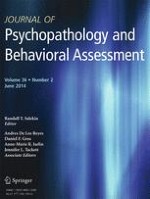01-06-2014
Advancing an Understanding of the Anxiety Control Questionnaire for Children (ACQ-C) in Clinically Anxious and Non-Anxious Youth: Psychometric Properties, Incremental Prediction and Developmental Differences
Gepubliceerd in: Journal of Psychopathology and Behavioral Assessment | Uitgave 2/2014
Log in om toegang te krijgenAbstract
A lack of perceived control over anxiety-related situations is theorized to be characteristic of anxiety disorders in children and adolescents. In the current study we tested several theoretical predictions and developmental variation with the Dutch translation of the Anxiety Control Questionnaire for Children (ACQ-C). The theoretical factor structure of anxiety control was tested using Confirmatory Factor Analysis (CFA) in 548 non-referred children (8–18 years old, M = 12.5 years; 50.7 % girls). The incremental predictive validity of perceived control for anxiety status was assessed using logistic regression in 141 clinically anxious children (age M = 12.6 years; 56.7 % girls) and 298 non-referred non-anxious children (age M = 12.6 years; 52.7 % girls). CFA showed that both a one-factor model and two-factor model (perceived control over internal reactions and external events) fit well. The one-factor model proved invariant across age and gender. Internal consistency was excellent (Cronbach’s α = .93). Two-month test-retest reliability was adequate. The ACQ-C was able to incrementally predict diagnostic status, even after controlling for age, gender and self-reported anxiety symptoms. Finally, both younger children and girls reported less perceived control, independent of anxiety level. Findings advance the understanding of the psychometric properties of the ACQ-C, the role of control in childhood anxiety and point to the potential utility of the ACQ-C in both clinical and community samples. The Dutch translation of the ACQ-C demonstrated sound psychometric properties.
